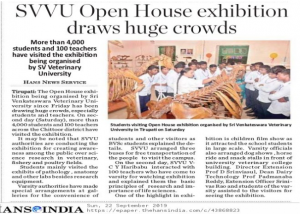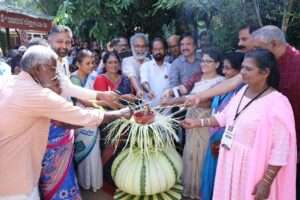Though veterinary universities contribute significantly to livestock sector development, the stakeholders, especially the livestock farmers, have very little understanding on the services they provide. In this meeting note, Drs. Sreenivasulu, Suresh, Sailaja, Triveni and Srinivasa Rao narrate how they organised an open house exhibition during September 20th to 22nd September 2019, to help stakeholders understand how the Sri Venkateswara Veterinary University (SVVU), Tirupati, is supporting the livestock sector in the state of Andhra Pradesh.
CONTEXT
Veterinary universities are established to achieve a three-pronged objective:
- Teaching to produce manpower to perform various roles of veterinarians in different institutions,
- conducting research to address problems in veterinary and animal husbandry domain and
- helping livestock farmers use animal production technologies, to handhold entrepreneurs in establishing livestock farms and livestock product processing units.
The success of a university in achieving these objectives depends upon the extent and level of participation of concerned stakeholders including veterinary students, faculty, livestock farmers and entrepreneurs, input suppliers and above all, the society in its activities. The universities are ultimately accountable to the society. However, many universities operate in isolation with little or no concern for the society and it may not be an exaggeration to say that the common man is not aware of their many activities.
Sri Venkateswara Veterinary University (SVVU) located at Tirupati, India, has opened its gates to the public for creating awareness about its activities by organising an open house exhibition, ‘EXHIVET-2019’, under the banner ‘Pashu Vaidya Viswa Vidyalaya Vignana Pradarshana’ from September 20-22nd. The exhibition created public awareness about the role of veterinary universities in serving the society through teaching, research and extension. In a way, this is necessary to provide accountability to the society which is expending huge resources in managing the university.
EXHIVET-2019
 To publicize and create awareness about veterinary science and animal husbandry, a logo was designed for the pupose and a brochure depicting all the events to be covered along with a route map, was released by Hon’ble Vice-Chancellor, Dr. Y. Hari Babu, in a special press meet organised for conducting the event. He indicated that the main purpose of Exhivet-2019 is to create awareness among the stakeholders, especially livestock farmers, general public, school children and college students about the role of the veterinary university in serving the society through training students in developing entrepreneurial skills, diagnosis and treatment of diseases, and educating livestock farmers in management of animals.
To publicize and create awareness about veterinary science and animal husbandry, a logo was designed for the pupose and a brochure depicting all the events to be covered along with a route map, was released by Hon’ble Vice-Chancellor, Dr. Y. Hari Babu, in a special press meet organised for conducting the event. He indicated that the main purpose of Exhivet-2019 is to create awareness among the stakeholders, especially livestock farmers, general public, school children and college students about the role of the veterinary university in serving the society through training students in developing entrepreneurial skills, diagnosis and treatment of diseases, and educating livestock farmers in management of animals.
The veterinary university has infrastructure to provide an understanding about animals, management of animals aged young to reproduction stage, disease diagnosis and treatment, processing of livestock products and to extend necessary help to livestock farmers and entrepreneurs. This open house exhibtion allowed farmers to visit and understand the different services provided by the University. The activities organised during this exhibition include the following:
- Visit to laboratories of all departments
- Visits to state of art infrastructure like Feed Analytical Laboratory, Embryo Transfer Technology Laboratory, State-level Disease Diagnostic Laboratory
- Visit to Pathology Museum of national repute, which has a collection of 290 specimens of various pathogolical conditions
- Visit to Anatomy Museum of national repute, which displayed skeletons of all the species like cattle, horse, elephant, sheep and goat, emu, poultry etc., and virtual dissection laboratory which gives real time learning experience.
- Display of mobile veterinary ambulance and mobile extension vehicle providing door-step services to livestock farmers.
- Display of equipment for establishment of small-scale dairy cottage industry for preparation of dairy products
- Sale of value-added milk and meat products.
- Demonstration of detection of milk adulteration and subclinical mastitis
- Exhibition and sale of publications and CDs on various aspects of livestock management and processing of value-added milk and meat products.
- Information on various courses offered by the University
- Dog show and horse jumping were organised in the college grounds from 4pm to 6pm every day.

The Hon’ble Vice-chancellor of SVVU, Dr Y.Hari Babu, addressed high school science teachers. A special session was organised to clarify their doubts on biotechnology, ecological balance and importance of livestock in the state’s economy. Hon’ble Director cum Vice Chancellor of Sri Venkateswara Institute of Medical Sciences, Dr. B. Vengamma, visited the stalls and interacted with staff and students. The distinguished guest, Sri.Balli Durga Prasad Rao, Hon’ble MP, Tirupati, showed keen interest on preparation, marketing and economics of different dairy products.

The participants visited the dairy, sheep, poultry and piggery farms and horse stables of the University. The participants were also exposed to the latest diagnostic facilities available for animal use at the veterinary clinical complex. Visit to fodder demonstration plots exposed the visitors to different fodder varieties and package of practices followed for their cultivation. Visit to feed mixing plant and the process of formulation of complete feed hopefully will encourage participants to feed their cattle complete feed.

The dignitaries interacted with teaching faculty of College of Fisheries Sciences, Muthukur, on culturing of fish and prawns. Many visitiors showed interest on culturing ornamental fish. Display of different species of fish and fish products was also organised at the event.
The students of the Department of Livestock Products Technogy demonstrated the meat products prepared by them under ‘Earn while you learn program’. The visitors appreciated the quality and taste of meat products displayed and offered for sale in the exhibition. Participants visited the Department of Poultry and observed different strains of layers, broilers, backyard poultry like Rajasri, Vanaraja, Giriraja; ducks, quails, turkey, guniea fowls etc. Eggs of emu and quails were the special attractions. CCVEC of SVVU displayed publications, CDs and DVDs on livestock management and disease control.

The public were curious to know about microorganisms responsible for spoilage of milk. The Quality Control and Analytical Lab of the College of Dairy Technology gave an opportunity for them to see different microorganisms under the microscope. The Department of Microbiology organised slides focusing bacteria causing diseases of economic and public health importance. The Department of Parasitology exhibited specimens of various ecto- and endo-parasites, charts displaying their lifecycles, and prophylactic measures to be taken for control of various parasitic diseases. State Level Diagnostic Laboratory demonstrated the methods to control mastitis, the economically significant disease of cattle and buffaloes. The visitors were informed about the significance of early diagnosis and prophylactic measures to be taken to control infectious diseases.

Display of skeletons of ox, horse, elephant, sheep, goat, dog, fowl, python, human etc. in the Anatomy Museum was a special attraction, especially for student visitors. Virtual dissection laboratory also attracted the attention of students. At the Pathology Museum, the faculty explained about specimens of different pathological conditions of various livestock species. At the Department of Veterinary Surgery & Radiology, various cancerous conditions of eye, horns, skin etc. and radiographic pictures of different fractures were exhibited.

The dog show organsied every day in the evening to show various breeds of dogs added special attraction to the exhibition with fun and frolic. Police dogs, trained in many ways including honouring dignitaries with bouquets, were part of the show. The NCC cadets of SVVU demonstrated the skills in horse jumping on all days of the exhibition.

CHALLENGES ENCOUNTERED
The organisers faced several challenges in organising this mega event for the first time without previous experience. The major challenges included crowd management, logistics and sudden onset of rains. Despite the deployment of student volunteers and non-teaching staff of the College of Veterinary Science, who were given proper counselling in advance, crowd management became difficult mainly due to sudden onset of rains and distant locations of the departments.
College canteen facilities were utilized for providing refreshments, food etc. on payment. The College of Dairy Technology, Tirupati, with the help of Heritage Foods India Ltd., provided the required drinking water packets to visitors. Sufficient parking facilities for school buses were provided on the campus and the vehicular traffic was controlled by the college security personnel. In addition, college buses were utilized to receive and drop the participants at bus stand / railway station.

LESSONS LEARNT
Timing: Events like these need to be organised before the onset of rains.
Scope for adding more diverse events: There is a scope to include more events such as:
- Live demonstration of clinical cases, surgeries, infectious agents, detection of food adulterations etc.
- Interactive sessions with students, teachers and farmers to address queries
- Stalls reflecting achievements of the university
- Sale of animal feed, mineral blocks, fodder slips etc. and
- More number of animal performances like dog shows and horse show jumping etc.
Visitor movement: Participants faced difficulty in visiting departments, which are located distantly. Hence, activities in such departments need to be arranged in the main building for convenience of visitors.
Publicity: Although efforts were made to reach the public through the involvement of the district administration, schools and colleges, and through media (radio broadcasts, advertisement in newspaper, supply of brochures etc.) only about 14,000 visitors (mainly from Tirupati and Chittoor district) could avail this opportunity to see various activities during the three days. This was mainly due to low-key publicity in the few days before the exhibition. Moreover, there was no entry fee for visitors.
Budget: This event was organised with a budget of Rs. 50,000. Keeping in view this limited budget, this event was highly successful. With proper advertisements and information sharing with various government departments of education, animal husbandry, agriculture and ATMA, the participation, especially from the neighbouring districts could have been higher. An amount of Rs. 65,000 revenue was also generated through sale of dairy, meat, fish products and publications. There is a lot of scope to improve these sales through increased supply of livestock products.
Similar events in more locations: Open house exhibitions need to be conducted in all districts where colleges and major research stations of SVVU are located. This helps people to know the facilities and activities of the university. It also helps to popularize the achievements of the university and further motivate young students to pursue animal husbandry education and related activities. Otherwise, the impact of the institutions like SVVU can be seen only within a short radius of about 10 to 20 km.
END NOTE
This exhibition has given an opportunity for the common public, students and livestock farmers to know about the activities of the Veterinary University and the courses and services it offers to various stakeholders of animal husbandry, which must be considered a social responsibility of the University. It also gave a unique opportunity for the faculty and staff of the University to showcase their activities and achievements to the common public.

Dr. D. Sreenivasulu, Director of Extension, SVVU, Tirupati, Email ID: desvvu@gmail.com

Dr. J. Suresh, Coordinator, CCVEC, SVVU, Tirupati, Email ID: ccvecsvvu@gmail.com

Dr. N. Sailaja, Professor, CCVEC, SVVU, Tirupati, Email ID: ccvecsvvu@gmail.com

Dr. G. Triveni, Associate Professor, CVSc, SVVU, Tirupati, Email ID: triveni04@gmail.com

Dr. D. Srinivasa Rao, T.O to D.E, SVVU, Tirupati, Email ID: srddasari@gmail.com
Acknowledgements: The authors are grateful to Dr.Y.Hari Babu, Hon’ble Vice Chancellor, SVVU, for his valuable guidance and inspiration in organising the extension activities in the university. They are also thankful to Dr SVN Rao, Professor of Extension (Retd.), Pondicherry for his valuable suggestions





Add Comment